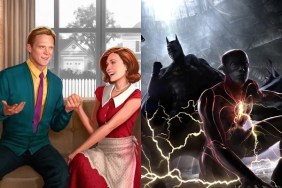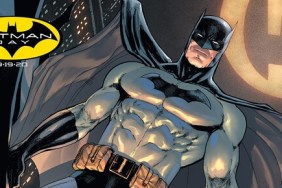Welcome to The World of Original Comic Art, a new recurring feature here at CraveOnline that is dedicated to a seldom explored area of comic book fandom.
The first thing that you need to know is that comic books are the marriage of words and pictures. It all starts with a script, but without the art, a comic is not a comic. Conversely, a piece of art (especially a sequential piece of art) can tell a story without words and still be a comic book. But there is an underlying script behind any comic book page, even if there aren’t any words on it.
In the comic book industry, the division of labor usually breaks down this way. There’s a writer, who comes up with the stories and dialogue. There’s a penciler, who is the primary illustrator of the comic. The penciler actually has the hardest job, as he or she has to convincingly bring the writer’s story to life. Comics are a visual medium, and it’s always going to be the artwork that catches the eye of a potential reader before they can read any of the dialogue.
Covers are usually the artists’ domain. This particular cover features the X-Men in pencils by artist Terry Dodson.

Next comes the inker, an artist whose role is often unappreciated outside of comic book circles. It’s the inker who provides definition, shadows, and a greater sense of depth to the image. A good inker is worth his weight in gold, because he or she can elevate the penciler’s work to another level.
Terry Dodson’s wife, Rachel Dodson inked the X-Men cover above, and it serves as a good example of what an inker brings to the image.

Assuming that a comic book is in color, there’s a specialized colorist who handles that job. Although some independent comics are deliberately rendered in black and white for stylistic purposes or to save money. Finally, the letterer is the person in charge of putting the words in place on the page. It’s almost always done digitally now, but the lettering used to be physically pasted directly on to the original artwork.

This is the final version of the X-Men cover, as colored by Terry Dodson.
At larger comic book companies, there’s an editorial team who guide the writer’s story and scrutinizes the art team for any needed corrections or direction. It’s also not uncommon for artists to also write their own books, or for indie comic book creators to do everything on their passion projects.
Now that I’ve laid out a very basic overview of what goes into a comic, you may have a better understanding about a key aspect of the original comic art world. There is only one of each page, which makes it a unique collectible. Once you have a published piece of comic book art, there’s no one else out there who can get exactly what you have.
Several months ago, I wrote a post about the way that most comic books aren’t truly valuable. Comic art is on the opposite end of that spectrum. It’s highly sought after by collectors and the best pages can command very high prices.
To give you an example, let’s start with Batman. That’s a hero that almost everyone should know.

That particular page was drawn by Jim Lee, and inked by Scott Williams. It was published in All-Star Batman and Robin The Boy Wonder # 1 as page 22, from a script by Frank Miller.
And it sold for $7,000 last night at ComicLink’s Featured Auction.
Of course, it helps that the page featured Batman and Robin. Popular characters do tend to drive up prices. But Jim Lee is also one of the most iconic artists in the comic book industry. Paired with his favorite inker, Scott Williams on DC’s flagship character and it’s a no-brainer.
Here’s another example. This is a page from Avengers Vol. 3 # 19 by penciler George Perez, and inker Al Vey from a script by Kurt Busiek.

Casual Marvel fans may not recognize her, but that is the Scarlet Witch in the big panel on the left as she and the other Avengers battle Alkhema, the second bride of Ultron. This page sold for $1,300 on ComicLink. Not as much as the Jim Lee Batman page, but still a very respectable amount. Perez is also one of the most popular comic book artists, and he is considered to be one of the definitive Avengers artists.
Finally, this is a personal favorite page of mine from Incredible Hulk vs. Superman # 1. This is from a Marvel and DC crossover comic, which is something quite rare. The two companies haven’t done an intercompany crossover for over a decade.

The artist on this page is Steve Rude, with Al Milgrom on inks. It’s very nicely done and it’s going to be auctioned on Heritage’s website later this month. It will also likely sell for a much lower price than either of the two previous pages above. And it’s not because this isn’t a beautiful page. It simply isn’t as attractive to some collectors as the Jim Lee Batman page or the Avengers page by Perez.
That’s another thing about comic art: there are no set prices. Truthfully, a page is only worth what you’re willing to pay for it. But the collector’s market has exploded for comic art and prices are skyrocketing. Casual comic art fans may soon find themselves repeatedly outbid on high end pieces by people who seem to have money to burn.
It’s entirely possibly that the current comic art market could eventually collapse and bring the prices down again. But that hasn’t happened in the last 15 years, and it doesn’t appear to be happening anytime soon.
There is another threat to the comic art collector market: the digital revolution. A growing number of comic artists are switching to pure digital artwork, which can be completed faster… but the tradeoff is that digital leaves no original art page to sell.
We’re not yet at the point where new original comic artwork isn’t appearing on a monthly basis. But that future does seem to be inevitable.
That’s it for our initial column. Tweet me @BlairMarnell if you have any comic art questions for my next column. Or feel free to let me know if you have any comic art topics that you want me to cover!








